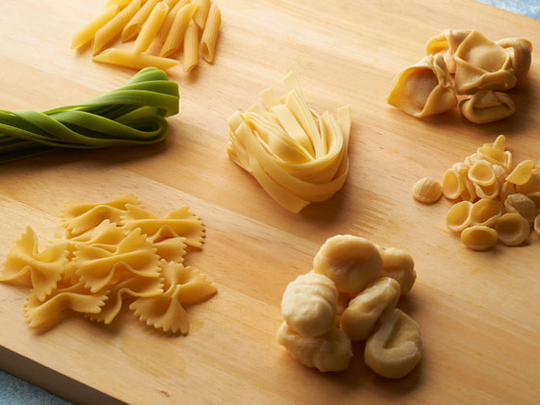
Wheel the supermarket cart down the aisle, drop a box of pasta into it. Next comes the bottled sauce. Boil, toss together and garnish. This is the perception of Italian culinary flair for most of us.
Thanks to fast food-ism the general populace has come to view pasta as tubes, twists and tagliatelles. It is quite notorious as a toss-it-together dish in the UK. While across the Atlantic, in upscale New York Italian restaurant BiCE, diners cough up an impressive $2,000 (about Dh 7,346) and more, for a plate of home-made tagliolini with fresh Maine lobster, wild mushrooms and generous shavings of black truffle, all served on a limited-edition gold-leaf plate designed by the late Gianni Versace, which diners get to take home. Such is the versatility of this Italian staple that it easily slips between common fare and haute cuisine.
Thankfully, an increasing number of diners are eschewing the box-and-bottle verity for authentic, handcrafted pasta a la italiano. After all, Italians have been pioneering the manufacturing and cooking of pasta for centuries, and as early as the 1600s machines existed to ensure its uniform shape and fast production. “There are more than 600 kinds of pasta in the world and 400 of those come from Italy,” says Claudio Melis, Executive Italian Chef Consulting, Jumeirah Group.
“The type of pasta depends on the region it comes from, for example, in the north of Italy, fresh pasta is made with 30 egg yolks and flour, whereas in the south it is made with semolina, flour and a few eggs or just water.”
Classic dishes
Melis serves diners an array of pasta dishes at Urbano, but firm favourites remain the ravioli di brasato — braised ossobuco served with a classic creamy green pea and ham sauce and the pappardelle in salsa di pollo — broad pasta noodles in chicken salsa, served with tasty mushrooms.
Alessandro Bottazzi, Chef de Cuisine, Ronda Locatelli, Atlantis The Palm, believes that people are still quite confused about authentic Italian cuisine, but there is a definite change too.
“Many food cities such as London, New York, Hong Kong and Tokyo have developed a high level of understanding and many non-Italian chefs are producing pasta the traditional way. Up until just ten years ago traditional pasta was made by Italians for Italians, but that is no longer the case, and a pretty remarkable innovation.”
Bottazzi still sees Dubai as a work in progress when it comes to developing an authentic Italian palate. But some of the changes can be seen in the various upscale restaurants that dot the city. At Sapori di BiCE, chef Marcello Rivetti uses fresh home-made pasta such as fettuccine, scialatielli, ravioli and gnocchi, while premium dry pastas such as penne, spaghetti, linguine and rigatoni are imported from Italy.
Chef Andrea Pastore at Positano, JW Marriott Marquis, serves the innovative pasta risottata, where the pasta is cooked directly in a sauce, making it far more flavourful. The new Positano menu will also serve a novel innovation — ricotta gnocchi.
Global demand
At the Cavalli Club, Head Chef Ernesto Tonetto, serves wholewheat ravioli stuffed with cod and sautéed tender stem broccoli; paccheri pasta with guinea fowl ragout and pioppini mushroom and buckwheat tagliatelle pecorino with cheese, lemon and pepper.
Globally too, the innovations in pasta are dynamic and an obvious response to the increasingly discerning taste buds. “Instead of using eggs and butter, companies are using flour made from microalgae,” adds Rivetti.
“Konjac root, also known as glucomannan, is also being used to make pasta. In Italy, food companies are developing ways to bring naturally fibre-rich grains such as durum, soy, ancients grains, flaxseed and nuts to the table.”


